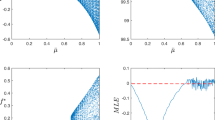Abstract
The standard account of Austrian Business Cycle theory posits that central bank manipulations of interest rates fool bankers and investors into believing that there has been an increase in the real supply of loanable funds available for capital investment. However, reliance on “foolishness” ignores the entrepreneurial emphasis within the Austrian tradition and fails to produce the strongest possible case for Austrian Business Cycle theory. We use the prisoner's dilemma framework to model the profit maximizing behavior of bankers and the investors under uncertainty when the market rate of interest is below the underlying rate of time preference.
Similar content being viewed by others
References
Cowen, T. (1997) Risk and Business Cycles: New and Old Austrian Perspectives. New York: Routledge.
Fackler, J. S., and McMillin, W. D. (1998) “Historical Decomposition of Aggregate Demand and Supply Shocks in a Small Macro Model.” Southern Economic Journal, 64(3): 648-664.
Garrison, R. W. (1986) “Hayekian Trade Cycle Theory: A Reappraisal.” Cato Journal, 6(2): 437-459.
Garrison, R. W. (1989) “The Austrian Theory of the Business Cycle in the Light of Modern Macroeconomics.” Review of Austrian Economics, 3: 3-29.
Hayek, F. A. (1933) Monetary Theory and the Trade Cycle. London: Jonathan Cape.
Hayek, F. A. (1935) Prices and Production. 2nd edn. London: Routledge.
Hayek, F. A. (1939) Profits, Interest, and Investment. London: Routledge.
Mises, L. [1971 (1912)] The Theory of Money and Credit. New York: Foundation for Economic Education.
Tullock, G. (1988) “Why the Austrians Are Wrong about Depressions.” Review of Austrian Economics, 2: 73-78.
Wagner, R. E. (1999) “Austrian Cycle Theory: Saving the Wheat while Discarding the Chaff.” Review of Austrian Economics, 12: 65-80.
Yeager, L. B. (1986) “The Significance of Monetary Disequilibrium.” Cato Journal, 6 (Fall): 369-395.
Rights and permissions
About this article
Cite this article
Carilli, A.M., Dempster, G.M. Expectations in Austrian Business Cycle Theory: An Application of the Prisoner's Dilemma. The Review of Austrian Economics 14, 319–330 (2001). https://doi.org/10.1023/A:1011985113936
Issue Date:
DOI: https://doi.org/10.1023/A:1011985113936




